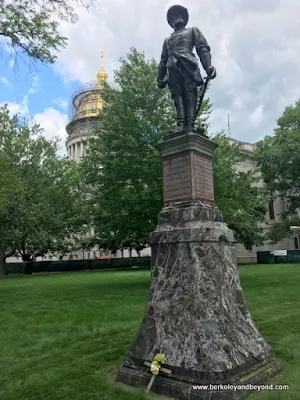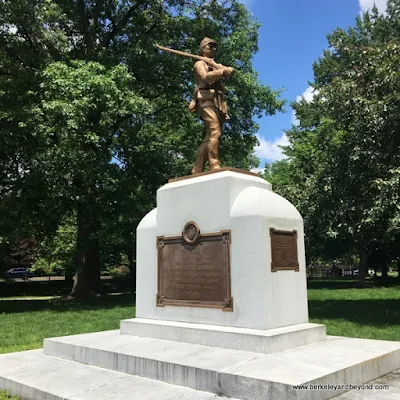Guest Post
Tour the Statues at West Virginia's State Capitol
by Renate Pore
images ©2019 Carole Terwilliger Meyers
THE CAPITOL
The classical-style West Virginia State Capitol sits on a
scenic site facing the Kanawha River. The
building was constructed in three stages between 1924 and 1932, and is one of the
most beautiful and impressive buildings in West Virginia. The architect behind it was Cass Gilbert, who
also designed the U.S. Treasury Annex and the U.S. Supreme Court in
Washington. The top of the building is
graced by a shining dome of 23.5 carat gold leaf. At the time of my visit, the dome was wrapped
in plastic for repairs. If you visit,
don’t expect to see the dome in all its shining glory until 2021.
Also located on the State Capitol grounds are the History
Museum and Governor’s Mansion. The Great
Hall of the History Museum displays hand-made quilts in honor of the state’s
tradition of quilting and other folk art.
THE STATUES
 |
| General Stonewall Jackson statue at the West Virginia State Capitol in Charleston |
#1
A jaunty General Stonewall Jackson stands on the lawn of the
West Virginia State Capitol. Jackson was born in western Virginia and won fame fighting for the
Confederacy even though his home would be one of 55 counties seceding from Virginia to join the Union
Cause. Commissioned in 1910 by the
Daughters of the Confederacy, the statue was created during the Jim Crow Era when
states and localities were passing laws to enforce segregation. Because of its association with a shameful
period in the nation’s history, there have been some calls to remove the statue
from its place of honor and relegate it to the State Museum. So far, however, Stonewall Jackson still
stands.
 |
| “Abraham Lincoln Walks at Midnight” statue at the West Virginia State Capitol in Charleston |
#2
“Abraham Lincoln Walks at Midnight” is another statue
commemorating West Virginia’s Civil War history. It stands on the south side of the State
Capitol and shows a grieving President Lincoln, sleepless because of the
pressing burdens of the Civil War. West
Virginia became a state in 1863 because the people of western Virginia
identified more with the North than with the slaveholding confederate states of
the South.
#3
On the west end not far from Stonewall Jackson stands the
statue commemorating 32,000 soldiers, sailors, and marines from West Virginia who fought for the
Union cause in the Civil War. Some years
ago when the bronze statue was repaired, it was coated with a plastic substance
which gives it its orange look. The strange hue was very upsetting to the
locals who were used to the seeing their statues in greenish bronze.
 |
| coal miner statue at the West Virginia State Capitol in Charleston |
#4
West Virginia is coal, and coal is West Virginia. A burly coal miner in a hard hat graces the
northwest side of the Capitol. The
base of the statue depicts scenes from the coal-mining era--from the days of
pick and shovel to continuous miners. Today,
coal mining is a dying industry and coal miners are working-class heroes from
another time. About 13,000 people
continue to be employed in underground or mountain-top-removal mining.
 |
| Veteran’s Memorial at the West Virginia State Capitol in Charleston |
#5
The West Virginia Veteran’s Memorial is a two-story oval
monument honoring more than 10,000 West Virginians who made the ultimate
sacrifice in defending the nation in twentieth-century conflicts. Composed of four limestone monoliths
surrounded by a reflecting pool, the interior walls are faced in polished black
granite etched with the names of these men and women. The Memorial was designed by P. Joseph
Mullins, who also sculpted the four figures representing the four major
twentieth-century conflicts and the four major branches of military service. The statue in the photo depicts a sailor from
World War II.
 |
| “West Virginia’s Female Veteran” statue at the West Virginia State Capitol in Charleston |
#6
The “West Virginia’s Female Veteran” statue is also part of the
West Virginia Veteran’s Memorial described in #6. The
statue of the woman warrior was the last piece added to the memorial. It became controversial when the sculptor
decided to depict the woman in fatigues. Female veterans wanted a statue showing a
woman in dress uniform. To accommodate
everyone, engraved copper plates around the base of the statue depict women in more
formal dress.
 |
| Booker T. Washington statue at the West Virginia State Capitol in Charleston |
#7
This statue of Booker T. Washington stands on the north side
of the State Capitol. Booker Taliaferro
Washington lived about 10 miles southeast of Charleston in Malden, West
Virginia. He was an educator, author,
orator, and advisor to United States presidents. The last of the black American leaders born
into slavery, he became a leading voice against the oppression of former slaves
and their descendants during the Jim Crow Era.
 |
| Anna Jarvis bust at the West Virginia State Capitol in Charleston |
#8
This bust of Anna Jarvis stands next to the information desk
on the main floor of the West Virginia State Capitol. Jarvis grew up in Grafton, West Virginia, and
is credited as the founder of Mother’s Day in the United States. After the death of her mother, she organized
an aggressive campaign to establish a National Mother’s Day, and thanks to her
efforts, by 1911 almost every state in the nation was celebrating Mother’s Day.
 |
| guest blogger Renate Pore |
Renate Pore migrated from California to West Virginia in
the late 1960s. Although there is no
place like California, Renate got hooked on West Virginia--the semi-rural life
style, the mountains, the breathtaking spring when all the trees suddenly burst
out in bloom and the serene days of fall when the weather is just like
California. Renate felt West Virginia
could use her skills and talents and has had a long and satisfying career as a
health care activist badgering federal and state policymakers to do the right thing on health
care. Renate is retired now but working
on events to celebrate the Centennial of the 19th Amendment--women's right to vote--and
its ratification in West Virginia. She
is a political junkie and looks to California to lead us to a new and better
place. Renate lives in Charleston with
her sweet, shaggy, red-haired boy, Ollie.
More things to do in Charleston, West Virginia.
More ideas for travel adventures in California and the U.S. and around the world.
updated 4-3-21






You hit a sweet spot with us, by visiting a state capitol. While we never intended to identify this as a specific reason to see a city, it seems to have become a common occurrence for us. We love the local artist's works, like the statues you showed us. Touring the various domes is another great activity.
ReplyDeleteThat's quite an impressive collection of statues ...the one of "Abraham Lincoln Walks at Midnight" is especially evocative. Not something often seen in monuments to important figures.
ReplyDeleteWhen I was a lobbyist I testified in many of our state capitols but not West Virginia. Looks like I missed a great place! I'll have to stop in next time I'm in WV!
ReplyDeleteGreat article.
ReplyDelete